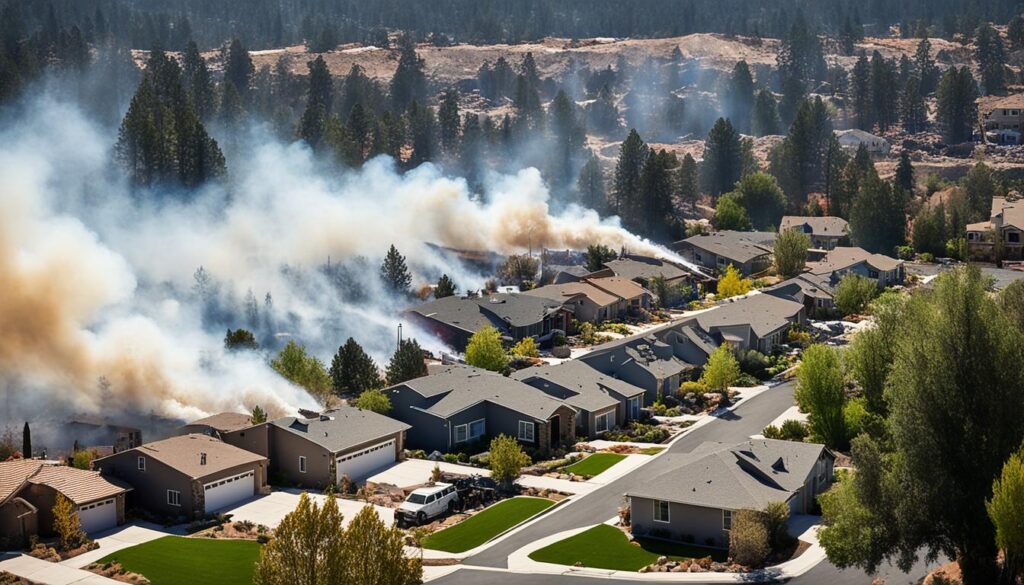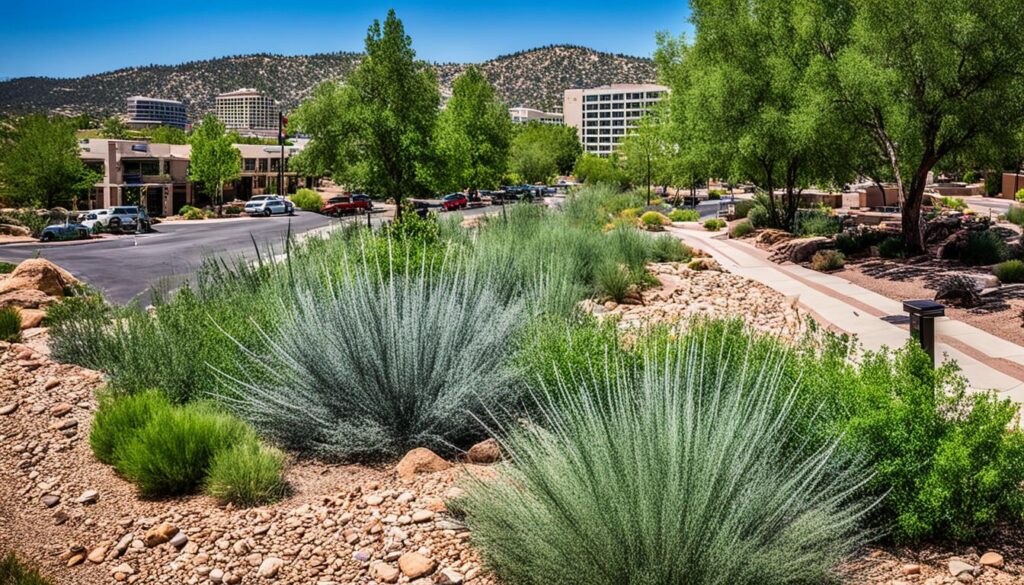
Firewise Landscaping is key to reducing wildfire risks in crowded places. In Prescott, AZ, the mix of city living and natural spaces brings unique problems.
Prescott faces the challenge of keeping natural beauty while making sure people are safe. It’s about managing plants, getting the community involved, and following rules. And, it’s about using fire-resistant methods.
In Prescott, AZ, people love the beauty of the area but also want to stay safe from wildfires. Firewise Landscaping is their way to protect homes and neighborhoods. Yet, it’s hard to achieve.
We’ll look into the problems of doing Firewise Landscaping in places like Prescott, AZ. We’ll talk about wildfire risks, how hard it is to manage plants, why the community needs to get involved, and the hurdles of rules and logistics.
Understanding these problems helps us make our communities stronger. It helps protect our homes and nature from wildfires.
Key Takeaways:
- Firewise Landscaping in densely populated areas helps mitigate the risk of wildfires.
- Prescott, AZ, faces unique challenges due to its mix of urban development and natural landscapes.
- Vegetation management, community engagement, and regulatory hurdles are key challenges to overcome.
- Prescott, AZ, serves as a case study for successful Firewise Landscaping in densely populated areas.
- By addressing these challenges, communities can enhance their resilience and protect against wildfires.

Understanding the wildfire risk in densely populated areas
Wildfires are a big menace to areas with lots of people. Effective strategies are crucial to lessen wildfire risks. These areas face unique problems like fast-moving fires and tough evacuation, showing the need for thorough risk checks.
To assess the risk, factors such as nearby flammable materials, and the presence of burnable vegetation are considered. Also looked at is how easy it is to escape. This helps identify high-risk zones, letting authorities focus on preventing wildfires there.
Understanding how quickly a fire can spread in these areas is key. Buildings being close together means fire can easily jump from one to another. This is a big danger. Evacuation can also become harder because there are not enough roads and leaving takes longer. This highlights the need for planning to lessen wildfire risks.
Assessing risks helps in making specific plans for wildfire prevention. It guides on where to reduce fuel, like making safe spaces around homes. It also suggests using materials that resist fire when building.
Risk assessment also teaches communities how to be ready. People learn what dangers their area faces and make better choices about protecting their homes. They plan how to leave safely and join in drills with others.
By mixing risk assessment, working together with the community, and taking action beforehand, areas with many people can be safer from wildfires. Putting effort into reducing wildfire risks means communities can better withstand these natural events. It safeguards both people and their homes.
| Factors | Risk Level |
|---|---|
| Proximity of combustible materials | High |
| Presence of flammable vegetation | High |
| Accessibility of escape routes | Medium |
| Building density | High |
| Road capacity | Low |
Vegetation management in urban settings
Firewise Landscaping in crowded areas faces challenges due to limited space and buildings being close together. Managing plants well is vital to lower wildfire risks and keep communities safe.
To manage urban vegetation, it’s important to have defensible spaces around homes and buildings. This means removing or reducing flammable plants, like dead trees and dry brush, within a set distance. Making a safety zone around buildings can slow down fires. This helps with evacuating people and fighting fires more safely.
Using fire-resistant plants is a smart move in crowded areas. These plants are less likely to catch fire, which can help keep buildings safe from fires. Adding these plants makes neighborhoods look better and safer from wildfires.
Keeping up with plant maintenance is key. Regular checks and cleaning up things like fallen leaves and twigs can stop fuel from piling up. It’s also important to cut branches close to buildings to stop fires from spreading easily.
Having the community involved is crucial for keeping areas safe from fires. Teaching people about Firewise Landscaping and getting them to help makes communities stronger. Groups and local governments can run workshops and offer help so homeowners can manage vegetation well.
To manage plants well in crowded places, everyone needs to work together. This includes locals, officials, and others. By focusing on lessening fire fuel and creating safe zones, communities can be better prepared for wildfires. This keeps everyone and their homes safer.

Community engagement and education
To make Firewise Landscaping work in crowded places, we need everyone to join in and learn. To build communities that can stand up to fires, everyone needs to help out. But, teaching lots of people in these areas can be hard.
Getting the community involved means getting people to care about their safety and their neighborhoods. By letting them know how key fire prevention is and the perks of Firewise Landscaping, they’ll help make their area safer.
Building Fire-adapted Communities
Fire-adapted communities have taken steps to be less affected by wildfires. With Firewise Landscaping and other actions, they’re much stronger against fires.
Talking to residents and giving them the info they need is essential. Community workshops, educational stuff, and online resources help a lot. This way, people can decide how to protect their homes better.
The Challenges of Reaching Densely Populated Areas
In crowded areas, spreading fire prevention news to everyone is tough. Still, we can use different strategies to get the message out there effectively.
- Using many ways to communicate helps reach more people. This includes meetings, flyers, newspapers, and also social media, websites, and emails.
- Working with local leaders and groups makes spreading the word easier. Trusted people and organizations in the community can amplify the message.
- Focusing on the most at-risk spots means we can target our efforts better. This way, we help those who need it the most first.
The Power of Education
Educating folks is crucial for fire-ready communities. Providing resources about Firewise Landscaping and how-to tips drives people to act.
Using visuals like infographics and videos can get the point across. They show how Firewise Landscaping works and inspire changes at home.
Keeping education going is key for lasting safety. Updates, workshops, and talks with fire officials keep everyone on the same page.
By focusing on getting people involved and educated, crowded areas can become strong against fires. With teamwork, good communication, and continuous learning, we can all live in safer places.
Overcoming regulatory and logistical hurdles
Firewise Landscaping in crowded places faces many challenges, not just with managing plants. Overcoming legal and logistical issues is key for wildfire prevention and making communities stronger.
In areas with many people, dealing with city planning laws can be tough. Rules about land use, zoning, and building codes can change a lot from place to place. This makes it hard to use Firewise Landscaping everywhere in the same way.
Different groups need to work together to overcome these challenges. Homeowners’ groups, local governments, utility companies, and community groups need to join forces. They must create detailed and workable plans that include Firewise ideas in city planning.
Deciding how to split up resources like workers, equipment, and money is hard in crowded areas. It’s tricky to meet the needs of different neighborhoods fairly. This task needs careful thought and teamwork.
Technology can help solve these logistical problems. Tools like GIS mapping give useful info about which places have the highest wildfire risk. With technology, planners can figure out the best places to focus their efforts.
Key Challenges:
- Varied land use regulations: Navigating differing regulations across jurisdictions
- Coordinating stakeholders: Collaborating between homeowners’ associations, government agencies, and utility companies
- Resource allocation: Balancing the needs of densely populated areas and prioritizing resource allocation
- Technology integration: Leveraging GIS mapping and data analysis for efficient planning
To get past these regulatory and logistical hurdles, a wide-ranging and team-based strategy is needed. By tackling these issues, urban planners and communities can effectively put in place Firewise Landscaping. This enhances safety and strength against wildfires in areas with lots of people.
Firewise Landscaping in Prescott AZ
In Prescott, AZ, Firewise Landscaping has helped prevent wildfire risks in crowded areas. The city faced hard challenges and needed new ways to keep people safe from wildfires. This method has made communities better prepared and stronger.
Prescott is famous for its lovely views but is very prone to fires. Thanks to local leaders and the community working hard together, they’ve made big improvements. Now, the community is better prepared for wildfires.
One big problem in Prescott was making safe spaces in crowded places. Another was cutting down on things that could burn. But, with careful planning of plants, using the right gardening ways, and choosing materials that don’t burn easily, people have made their homes safer. This effort cut down the chances of losing homes and lives.
Teaching the community was also key to Firewise Landscaping’s success in Prescott. Through events and meetings, people learned how to protect their homes. Knowing more led to everyone helping out. Neighbors started working together to stop fires from spreading.
The Firewise Landscaping initiative in Prescott shows how effective it can be. With a focus on safety and working together, Prescott is now a leading example for others. Other places with the same problems can learn a lot from Prescott’s experience.
At Yavapai Landscaping, we provide expert snow removal services in Prescott, Arizona. Our team is dedicated to delivering efficient snow plowing, blowing, and shoveling to safeguard properties against winter hazards. We’re available 24/7, including holidays, ensuring safety and accessibility for our clients. We tailor our services to each property’s specific needs and utilize professional equipment for top-notch results. Our focus is on both residential and commercial clients, prioritizing their satisfaction and safety in all our snow removal tasks.
